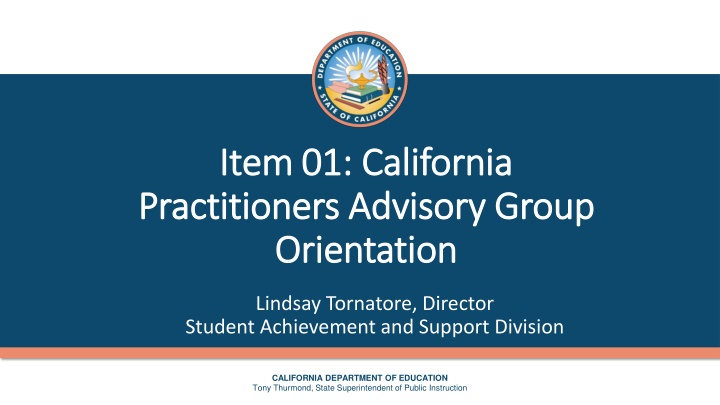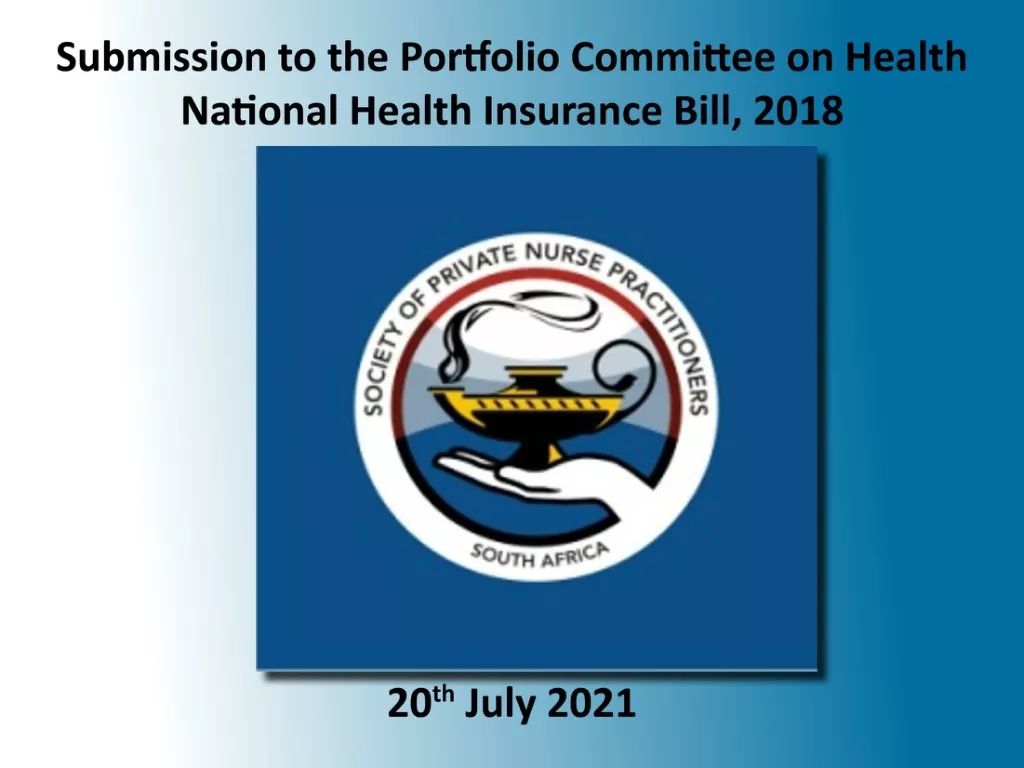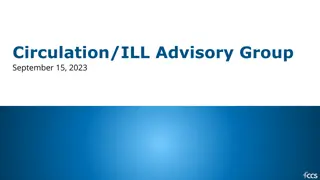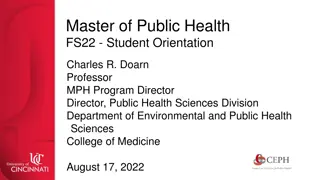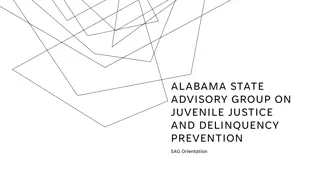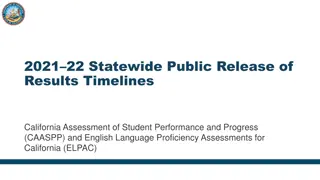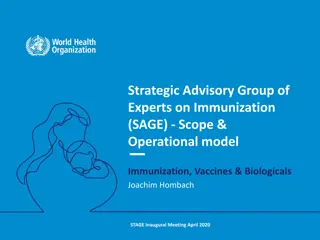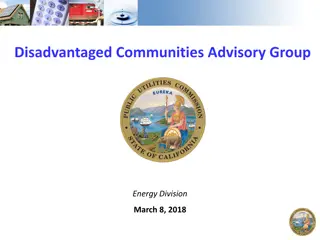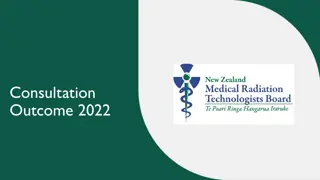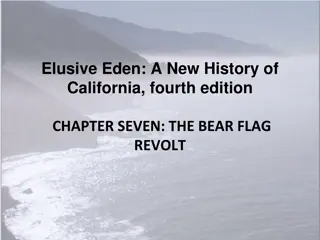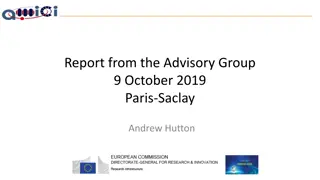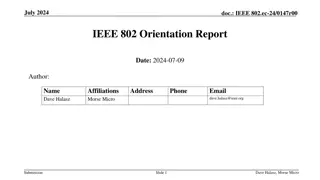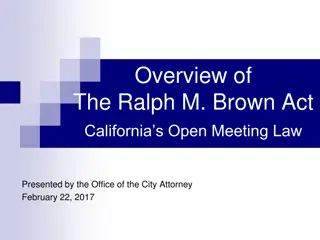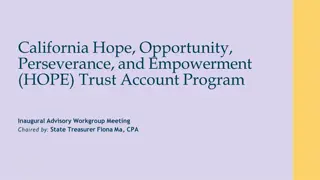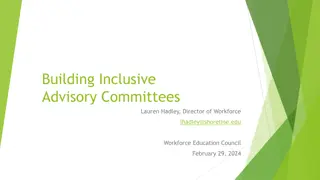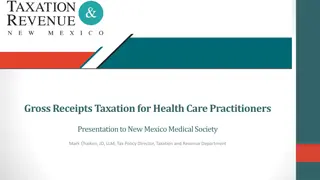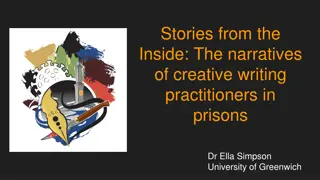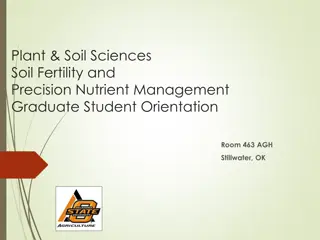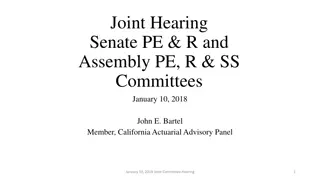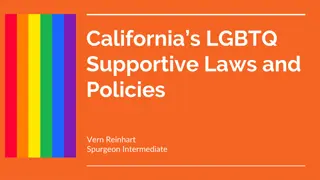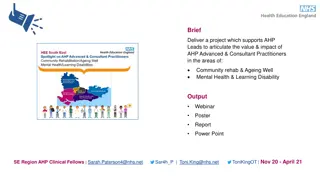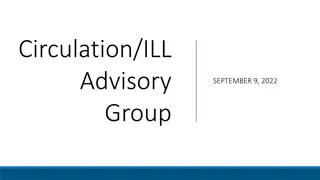California Practitioners Advisory Group Orientation
State Superintendent of Public Instruction, Tony Thurmond, leads the California Practitioners Advisory Group to provide input on educational decision-making and accountability systems in California.
Download Presentation

Please find below an Image/Link to download the presentation.
The content on the website is provided AS IS for your information and personal use only. It may not be sold, licensed, or shared on other websites without obtaining consent from the author.If you encounter any issues during the download, it is possible that the publisher has removed the file from their server.
You are allowed to download the files provided on this website for personal or commercial use, subject to the condition that they are used lawfully. All files are the property of their respective owners.
The content on the website is provided AS IS for your information and personal use only. It may not be sold, licensed, or shared on other websites without obtaining consent from the author.
E N D
Presentation Transcript
Item 01: California Item 01: California Practitioners Advisory Group Practitioners Advisory Group Orientation Orientation Lindsay Tornatore, Director Student Achievement and Support Division CALIFORNIA DEPARTMENT OF EDUCATION Tony Thurmond, State Superintendent of Public Instruction
Gratitude Gratitude TONY THURMOND State Superintendent of Public Instruction
Background (1 of 2) Background (1 of 2) Title I of the Elementary and Secondary Education Act, as amended by the Every Student Succeeds Act (ESSA) (Public Law 114- 95 Section 1603, 20 United States Code Section 6573), requires each State educational agency that receives Title I funds to create a State committee of practitioners to advise the State in carrying out its responsibilities under Title I. CALIFORNIA DEPARTMENT OF EDUCATION Tony Thurmond, State Superintendent of Public Instruction
Background (2 of 2) Background (2 of 2) The California Practitioners Advisory Group (CPAG) serves as this committee of practitioners for California and provides input to the State Board of Education on ongoing efforts to establish a single coherent local, state, and federal accountability system. CALIFORNIA DEPARTMENT OF EDUCATION Tony Thurmond, State Superintendent of Public Instruction
Purpose (1 of 2) Purpose (1 of 2) To provide input to the SBE on practical implications of decisions before the SBE, which may include providing input on the design of the Local Control Funding Formula evaluation rubrics and other decisions related to implementing the Local Control Funding Formula. CALIFORNIA DEPARTMENT OF EDUCATION Tony Thurmond, State Superintendent of Public Instruction
Purpose (2 of 2) Purpose (2 of 2) Accordingly, the CPAG will review any State rules and regulations relating to Title I of the Elementary and Secondary Education Act, as amended by the Every Student Succeeds Act, in order to advise the state in carrying out its Title I responsibilities. CALIFORNIA DEPARTMENT OF EDUCATION Tony Thurmond, State Superintendent of Public Instruction
Important Webpages Important Webpages CPAG Homepage can be found at: https://www.cde.ca.gov/be/cc/cp/ CPAG Bylaws can be found at: http://www.cde.ca.gov/be/cc/cp/cpagbylaws.asp CALIFORNIA DEPARTMENT OF EDUCATION Tony Thurmond, State Superintendent of Public Instruction
CPAG Support and Coordination Team CPAG Support and Coordination Team Art Cruz and Chris Aban, Student Achievement and Support Division, CDE Sara Pietrowski, State Board of Education CPAG@cde.ca.gov CALIFORNIA DEPARTMENT OF EDUCATION Tony Thurmond, State Superintendent of Public Instruction
Bagley-Keene Open Meeting Act California Department of Education Terrence Ohler, Deputy General Counsel (2/19/21 for CPAG) 9
Purpose of the Act - Transparency in decision-making reigns supreme Public participation in government outweighs efficiency Communications or discussions by a majority of members, without public participation, violates the Act 10
Background - Enacted in 1967, the Bagley-Keene Open Meeting Act ( Act ) is found at Gov. Code 11120-11132 and sets forth the open meeting requirements for state bodies. Modeled after the Ralph M. Brown Act (1953) Legislative intent of Act: that actions of state agencies be taken openly and that their deliberation be conducted openly. (Gov. Code 11120.) In response to COVID-19, the Governor has signed executive orders, which, among other things, make it easier to hold meetings by teleconference. (See Executive Order N-29-20.) 11
Definition: Meeting - When the majority of members: (1) Meet or otherwise communicate, (2) to hear, discuss, or deliberate upon any item, (3) that is within the subject matter jurisdiction of the state body. (Gov. Code, 11122.5.) Caution: a subcommittee of three or more CPAG members may constitute a state body, making the Act fully applicable to that subcommittee. A majority of a subcommittee is a much smaller number! (Gov. Code, 11121.) 12
Not limited to action or voting - Hear, discuss, or deliberate. Hear, discuss, or deliberate. Examples -- Study sessions or even pre-meeting briefing sessions. (Rutter, Adm. Law, citing AG Office s Handy Guide. ) -- Conversations on an issue within CPAG s jurisdiction. -- Any aspect of the deliberative process. 13
Serial Meetings Prohibited - Serial meeting refers to a series of communications, each of which involves less than a majority of members, but which taken as a whole involves a majority of the body s members. The main idea is that a state body s members cannot get around what must be done through a public meeting by having a series of off-the-record communications. Remember that emails, phone calls, and text messages are communications. Examples: -- A series of communications with one person and members of the state body may result in a serial meeting. -- Also, a chain of communications may result in a serial meeting. (See p.5 of the Attorney General Office s Handy Guide. ) 14
Practical Advice to Avoid a Serial Meeting- When you receive informational memos/agenda items, do not communicate among yourselves about the information or item outside of a properly noticed public meeting. On email, do nothit reply to all ! 15
Special Rules for Telephonic Meetings of an Advisory Commission - The ordinary rules for telephonic meetings of advisory bodies such as CPAG differ from other state bodies. (See Gov. Code 11123.5, as compared to Gov. Code 11123.) In response to COVID-19, the Governor signed Executive Order N-29-20, which has special rules applicable to all state bodies including advisory commissions. For now, for example, o There is no requirement that each teleconference location be accessible to the public. o There is no requirement that at least one member of the state body be physically present at the location specified in the meeting notice. o The public must be given notice of how it may observe the meeting and offer public comment. 16
Notice of Meeting - Notice of the meeting at least 10 days before. The Notice must include the date, time, and location of the meeting. The Notice must include the name and contact information of any person who can provide further information before the meeting. The Notice shall include a specific agenda containing a brief description of the items of business, which generally need not exceed 20 words. (Gov. Code 11125.) 17
Agenda Items - Cannot deliberate on an item not on the agenda. Must allow for public comment on each agenda item. Can limit the amount of time for each speaker. Can ask, but not require, members of the public to sign in. (Gov. Code, 11125 and 11125.7.) 18
Closed Sessions - Closed sessions are only permitted in limited situations. (E.g., pending litigation, personnel matters.) Consider consulting counsel if you think a closed session is necessary. (Gov. Code, 11126.) 19
The Public Has Important Rights - The right to attend The right to notice Accessibility Can t be required to sign in The right to record the meeting The right to address the body The right to criticize The right to agendas and other relevant writings prepared by or presented to the state body 20
A Violation Can Have Serious Consequences- A violation of Bagley-Keene may result in misdemeanor criminal prosecution (Gov. Code 11130.7) Actions taken in violation of the law may be void (Gov. Code 11130.3) Attorneys fees (Gov. Code 11130.5) Harm to the agency s reputation 21
Communications Among Board Members - You can have purely social conversations. You can have purely social conversations. A majority may attend a training or other event if others are in attendance and A majority may attend a training or other event if others are in attendance and you do not discuss issues within your jurisdiction. you do not discuss issues within your jurisdiction. 22
Communicating with the Public Outside of the Meeting - Share the work of CPAG. Indicate whether the views expressed are those of CPAG or your own. Listen. Do not indicate how you intend to vote on a pending matter. Thanks for listening! 23
Resources Executive Order N-29-20 (See https://www.gov.ca.gov/wp-content/uploads/2020/03/3.17.20-N-29- 20-EO.pdf) Executive Order N-35-20 (See https://www.gov.ca.gov/wp-content/uploads/2020/03/3.21.20-EO-N- 35-20.pdf) Memorandum from the Department of Consumer Affairs dated February 6, 2017, regarding the subject "Public Meetings, Bagley-Keene Open Meeting Act Guide" (See https://www.dca.ca.gov/publications/bagleykeene_meetingact.pdf) Attorney General s, A Handy Guide to The Bagley-Keene Open Meeting Act 2004 (See https://oag.ca.gov/sites/all/files/agweb/pdfs/publications/bagleykeene2004_ada.pdf) 24
Phone Number: (669) 900-6833 Meeting ID: 898 4974 9360# Passcode: 193608 Public Public Comment Comment Line Line TONY THURMOND State Superintendent of Public Instruction
